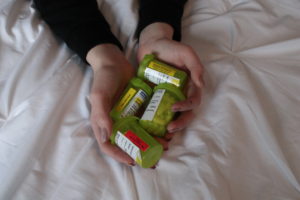Everybody bleeds, and it’s time people start talking about it.
Endometriosis. Heard of it? Even if you haven’t, its likely someone you know has it.
March is Endometriosis Awareness Month. One in 10 women suffer from the little-known disease according to the Endometriosis Network of Canada. For most of us, that means at least one of our family members or friends suffers in silence once a month.
Taylor Hollohan, 20, began her battle with endometriosis two years ago when she started experiencing pain in her right side. She went to the hospital one evening when the pain was particularly unbearable, expecting to be diagnosed with appendicitis. Instead, she was rushed into surgery to remove an eight-centimetre cyst from one of her ovaries.
Endometriosis is the growth of a woman’s uterine lining occurring outside of the uterus. It’s difficult to diagnose without surgery, and the only option for a ‘cure’ is a complete hysterectomy – meaning removing the uterus completely.
“Ever since (surgery), every few months, I would get these random pains in my stomach. Like awful, awful cramping,” said Hollohan. “Like your menstrual cycle, but ten times worse.”
At first, she tried her best to ignore it. When the pain came, she would consider going to get it checked out, but just like that, it would be gone again. Until it wasn’t.
Hollohan scheduled an appointment with her gynecologist and was misdiagnosed with muscle pain.
“The pain would come back and go every few months, but in November of 2017 I started my menstrual cycle as usual and it (the menstrual cycle) is still happening,” said Hollohan.

Endometriosis is a spectrum, she says. Some people experience more pain than others. Some people don’t experience any pain. But the only people who can truly understand what it’s like are the ones who have it.
“It’s driven me to a very, very bad space these past few months,” said Hollohan. “When you’re in constant pain, it literally destroys you.”
Hollohan says almost every time she goes to her doctor to complain of pain, she’s handed a new pill, gesturing to a large ziplock baggie filled with bottles of prescriptions on her bedside table.
A familiar fate
Hollohan’s story is all too familiar for those suffering from endometriosis.
Emily Murphy experienced her first symptoms at 14, and since then it’s been a battle of pain management. Much to her frustration, there is no cure for endometriosis.
“I’ll wake up in the morning and I’m can’t stand up straight because (of) the cramps,” said Murphy. “They start at my mid-abdomen and go down to my mid-thigh, and I’m not able to stand up straight because my muscles are so clenched.”
“If I were to describe how it feels, it’s like someone going inside you and squeezing your ovaries with tweezers,” said Hollohan. “It’s not only my stomach, it’s my lower back and legs too.”
The pain has taken its toll on Hollohan’s entire life. It’s depleted her mental health, physical health and emotional health. Its impacted her relationships with friends and loved ones.
It’s changed her life – for the worse.
Murphy experiences debilitating cramps along with nausea, headaches and irregular periods. Some days, she says, she can’t bring herself to go to work or school because of the pain.
“There are sometimes if I’m overcome with a cramp, I’ll just pretend to tie my shoe so I’ll curl up on the floor and pretend… “ said Murphy, “But really I’m just suffering through a cramp.”
Like Hollohan, when Murphy visits her doctor to complain of pain she is given medication for pain management – because besides having a complete hysterectomy, it’s the only option for relief.
“I wish people knew that it’s not just bad cramps,” said Murphy. “Everyone’s period is different, but I’m not just having a bad cramp; it takes over my entire body.”
Hollohan and Murphy alike both shared that they find their solace with people who understand what they’re going through. For Murphy, it’s her own mother, who has also suffered from endometriosis.
Hollohan, however, found her support in a Facebook group filled with women all over the world.
“It’s nice to see that someone else feels the same way you do,” she said.
Until a cure is found, a support group and some pain pills will have to do, says Hollohan.

Be the first to comment